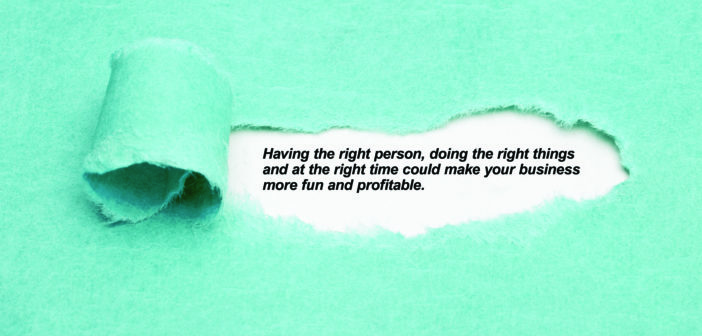Finding & Leading Top Performers

Beth Standlee
By Beth Standlee, CEO, TrainerTainment
Bringing the right team members aboard has always been a mission-critical task. In these days when it can be challenging to even find workers, it remains essential to hire the right person and understand what you need to do to develop and keep them.
Best Practice # 1: It’s difficult to get great performance from the wrong person.
If you are hiring for “breath and transportation” only, it’s likely you may have plenty of no-call, no-show experiences. Each week, and sometimes daily, I consult with a business owner who believes they have to take anyone who shows up for the interview. I get it, the hiring market is tough. But isn’t it tougher to have the wrong person? Does that ever really work out? The cost can be astronomical.
In a recent “Topgrading” article (topgrading.com/resources/mis-hire-calculator/), an entry-level employee can cost as much as 1x their annual pay. So, a short-term, front-line team member who makes $12 per hour and works 15 hours per week is likely to cost more than $9,000 in recruiting, hiring, training, paperwork and more. And we can’t even measure the lost business from the guests who never return because of a negative interaction with the “wrong” team member. So, doesn’t it make sense to figure out who the right person is and determine to only hire that one?
Best Practice # 2: Determine who the “right” new hire is.
Think about the three best team members you’ve ever worked with and list their names on a piece of paper. Then list the traits and characteristics that came to mind as you thought of your best. Next, evaluate your current team. How are they measuring up? Can you speak directly to them about their performance in specific areas so they, too, can make your “best team member” list? Finally, determine to dig in and ask specific questions of your next new hire to see if they can list real examples of when they have exhibited the traits and characteristics of your “best team member” list.
I know you may be thinking you don’t have time, you need people now, etc. However, financially speaking, can you continue to afford to turn people over? Having the right person, doing the right things and at the right time could make your business more fun and profitable.
Best Practice # 3: Real motivation is an inside-out move.
Dan Pink, leading researcher in motivation and author of Drive & To Sell is Human, teaches us that real, sustainable motivation is intrinsic. When we can help people know they have autonomy, mastery and purpose in their work, we can enjoy higher levels of performance. Extrinsic sources of motivation like reward, recognition or fear only work as long as the manager is feeding the team member with these external sources. Learn your team members’ real purpose behind their work. Share the big picture of your business with everyone in the organization. Help your employees master their jobs and give them ownership of their area. This leads us to best practice #4.
Best Practice # 4: Positively reinforce the behaviors you want to see.
Only an individual employee knows (and will show management) what works for them specifically, but there are statistics that indicate that 70% of people respond better and provide more discretionary effort when the behaviors you want are positively reinforced. A manager asked me one time, “Beth, do you mean I have to tell a team member what a good job they’ve done when they show up for work on time?” My reply was, “Yes, if that’s what you want every time!” It seems like a simple thing, but I think since we expect people to do their jobs, it’s easy to overlook the superstars. Many times, our energy is spent trying to correct bad behavior rather than appreciating and recognizing the good stuff that goes on a daily basis.
Best Practice # 5: The “Positivity Sandwich” doesn’t work for the team member!
You know what I mean: It’s difficult to provide correction and direction when a team member isn’t performing the way you want them to. There can be some anxiety when you feel like you need to have a difficult conversation with an employee. So, the manager may sandwich the negative within positive messages.
For example, starting with this positive, “Beth, we really love having you on the team.” Then, following with a negative: “However, you keep arriving 10 minutes late for your shift. I need to know what you are going to do to be sure you make it on time.” Finishing with another positive: “Now please know, we really love your enthusiasm and are so happy you joined our team!”
That’s confusing, right? Am I in trouble? Do you like me? How serious is the late thing? The positivity sandwich only works for the manager having to deliver the corrective action. It makes them feel better but sets the employee up to wonder when the other shoe falls anytime the manager offers up a positive comment!
I hope these tips help in this challenging labor market. Remember, front line-first time employees are a great responsibility, and they are not part of the unemployment market. See what you can do to help a new team member enter the working world successfully. Both that person, both short- and long-term, and your business will benefit.
Beth is the CEO of TrainerTainment LLC, a training company devoted to the family entertainment and hospitality industries. Beth and her team are focused on helping the companies they serve to make more money through sales, guest service, leadership and social media marketing training. Training products and services are delivered in person, through books and DVDs, and virtually with e-learning courses, webinar development and 24/7 online access. Visit her company’s website at www.trainertainment.com.




